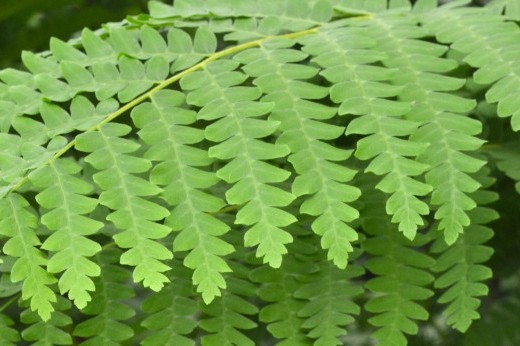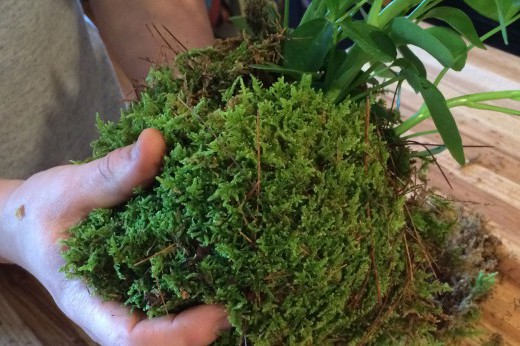What if you could make unlimited copies of your favorite houseplant to share with all your friends? Or make copies of your friends’ houseplants to add to your own collection? You can! Many common houseplants are easily multiplied, or propagated, asexually. Since this does not involve growing from seed, you can reproduce plants quickly this way. And each plant you propagate is a genetic copy of the original. Read on to learn the basics of three simple methods for propagating many common houseplants.
Materials
For most propagation methods, you will need:
- A sharp, sterile cutting tool (pruning shears, an X-Acto knife, or even a good pair of scissors). The sharper the tool, the cleaner the cut and the less damage done to the original plant. Sterilizing the tool (using diluted bleach or rubbing alcohol) in between cutting different plants reduces the risk of transmitting disease.
- Potting media. Generally, a potting mix that includes something like perlite (for drainage) is best. You can use a seed germination mix or a regular potting soil mix and add perlite or sand. What you’re looking for is a mix that won’t remain too soggy, so your cuttings don’t rot.
- Rooting hormone. This is optional. All the plants listed below root just fine without it. Plants produce a natural rooting hormone and different species produce different amounts. If you do choose to use rooting hormone, just follow the directions on the label.
- Containers. Shallow containers with drainage holes on the bottom, like a nursery tray or small pots, are best. Since your cuttings will not yet have roots, you do not need much potting media to start with. This will also reduce the chance of rot.
- Suitable location. Cuttings should be kept in bright, indirect light. Even if it’s a plant that will eventually be moved into direct light, when it is getting established, you don’t want it to transpire (release water) too quickly. Once your plant has roots, you can move it, but if you’re moving it into direct sun, do so gradually, to avoid burning the leaves.
Houseplant Propagation Methods
Division
Division will give you an instant new plant because you are simply separating new plants (with roots!) that have already generated from the original plant. There are a few different ways that parent plants will develop plantlets that can easily be divided.
- Stolons (aka runners). Spider plants (Chlorophytum comosum), for example, produce new plants on long specialized stems called stolons. The plantlets can simply be snipped off and potted up.
- Offsets. Offsets are also produced on adjoining stems, but these stems are short, so offsets must be more carefully separated from the original plant. For plants such as aloe (Aloe spp.), haworthia (Haworthia spp.), or gasteria (Gasteria spp.), remove the entire plant from the pot and gently tease apart the offsets, snipping the connecting stems as needed. After potting up the offsets, repot the parent plant, adding additional potting soil as needed.
- Rhizomes. Rhizomes are fleshy stems that grow underground horizontally. After gently uprooting the parent plant, rhizomes can be sliced vertically to produce multiple plantlets. Ginger (Zingiber officinale) and umbrella papyrus (Cyperus alternifolius) can both be propagated this way, as well as the popular ZZ plant (Zamioculcas zamiifolia). Repot the parent plant afterward, adding additional potting soil as needed.
For all three types of divisions, simply plant the newly divided plantlet into an appropriately sized pot of potting medium, pat it down gently, and water. A good rule of thumb is to select a pot that gives about 1–2 inches of soil space all around and underneath the plant. Patting the soil and watering immediately after transplanting ensures that there are no large air spaces and that all roots are in contact with the soil.
Stem Cutting
Before you make your stem cutting, you need to identify the plant’s nodes. These are the points along the stem where the leaves are attached. Always make your stem cuttings on the internode, the stem area between two nodes. Never cut too close to the node because this is the place where new roots will develop.
- Internodal stem cutting. This method works well on many hanging or vining plants, including heart-leaf philodendron (Philodendron hederaceum), zebrina (Tradescantia zebrina), and pothos (Epipremnum aureum). Cutting anywhere between two nodes means you can produce many new plants from the original plant. Make your cuts on the stem in between two nodes and place the cutting horizontally, so that the node is in contact with the potting media, while the leaves remain above ground. Alternatively, you can place your cutting into a cup of water and wait until roots begin to develop before potting.
- Stem tip or apical cutting. In this method, you will make just one cut per growing stem and your cutting will include the growing tip (the topmost node) of the plant. Make the cut on the stem above a node. Carefully remove the leaves from the lower node (or nodes) and nestle the cutting vertically into the potting mix. Streptocarpella (Streptocarpella saxorum), geranium (Pelargonium spp.), and coleus (Plectranthus scutellarioides), and other mint-family species, propagate easily this way. Alternatively, you can place your cutting into a cup of water and wait until roots begin to develop before potting.
Leaf Cutting
Propagating from leaf cuttings results in entirely new little plants that grow from the base of the cutting. When selecting which leaf to make your cutting from, look for healthy ones that have grown to full size, but aren’t too old. Once the new plant has developed new roots, stems, and leaves, the “parent” leaf can be removed if desired.
- Leaf with petiole. The petiole is the stalk of the leaf that is attached to the plant stem. To make more African violets (Saintpaulia ionantha) or begonias (Begonia spp.), the easiest method is to snip off healthy new leaves (cutting on the petiole, close to the stem) and nestle the petiole into a container of potting mix, ensuring that the leaf blade is not touching the soil.
- Leaf without petiole. Some plants’ leaves have no petiole so are attached directly to the stem. Many succulents, including Burro’s tail (Sedum morganianum) and jade (Crassula ovata), can be propagated by gently breaking a leaf from the stem and setting the leaf cut-side down into the soil just deep enough so the leaf is supported in a vertical position. Succulents are slow-growing plants, so you’ll need to be patient when propagating them.
- Lateral cutting. The only plant I’ve ever propagated successfully this way is the very forgiving snake plant (Sansevieria spp.). Use a sharp blade to slice one long leaf from the plant. Then slice that leaf horizontally into 3-inch pieces, making sure that you keep the pieces oriented in the same way they were growing originally. Plant each section about a quarter-inch deep in potting mix, bottom-side down and top-side up!
Most plants propagated using one of these methods will develop their root systems under the soil over several weeks. You will then start to notice leaf and stem growth as they establish themselves. After about three months, your new plants will look a lot like the originals.



